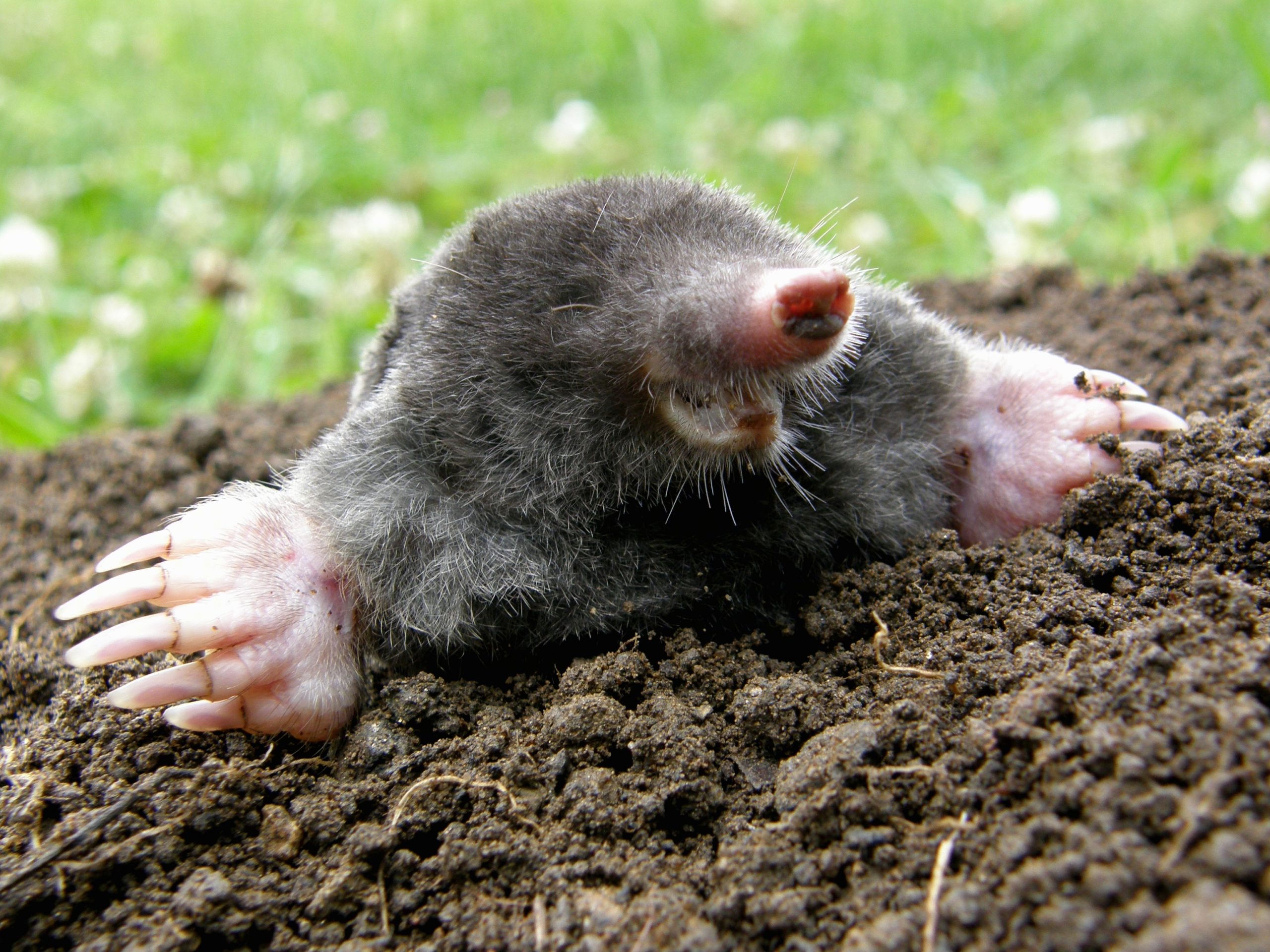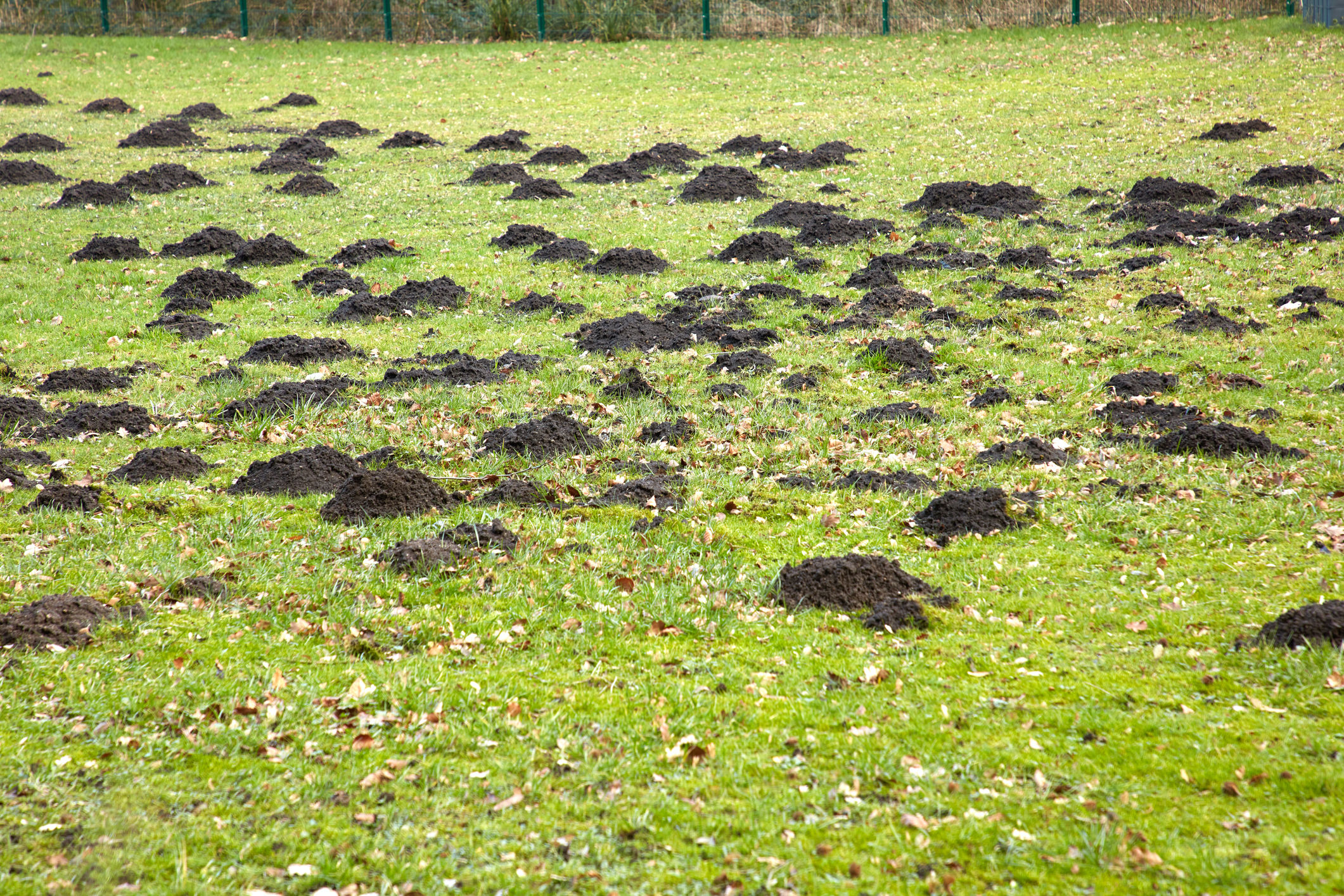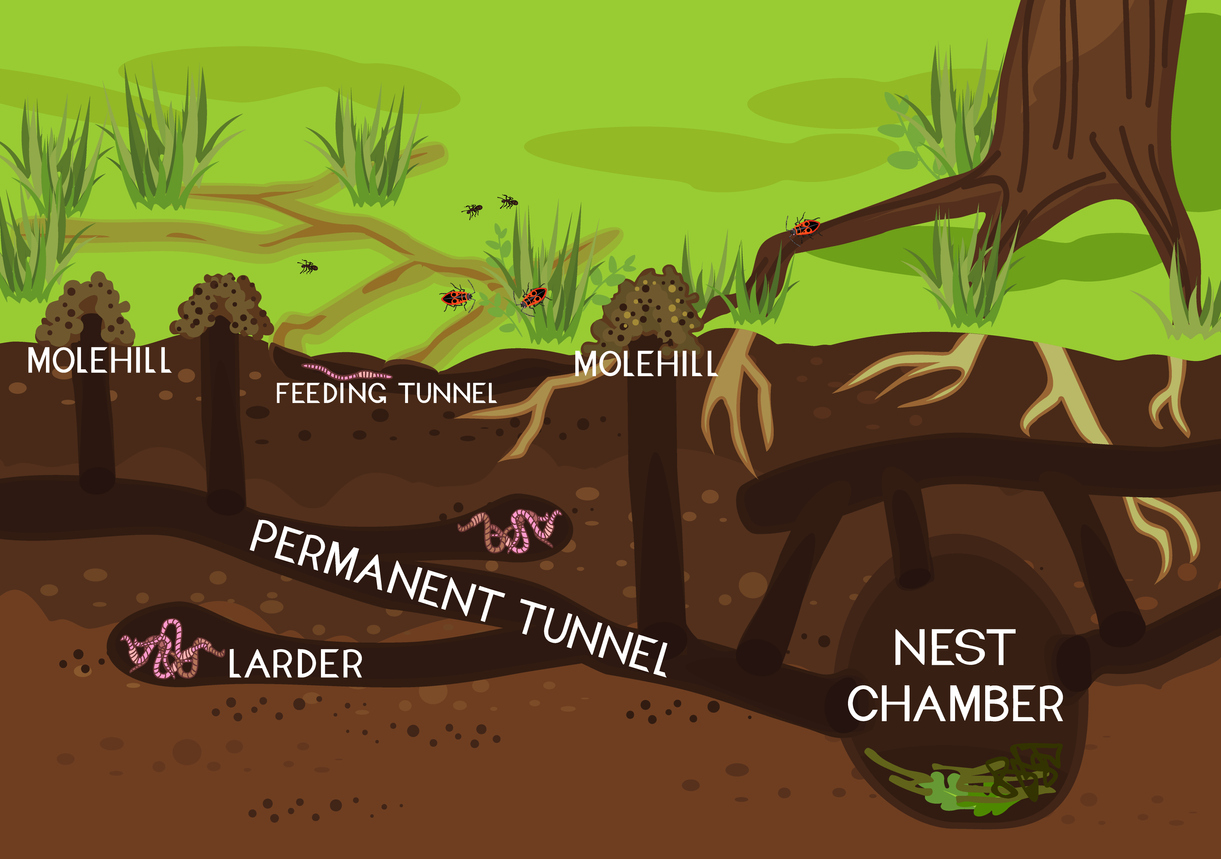Because it lives underground, a mole might be difficult to get rid of. The team at Merlin Environmental has provided mole control services that have helped thousands of clients reduce mole populations and once again enjoy their landscape. Here are some tips and tricks on how to get rid of moles.
Keep your lawn neat and tidy.
Undercover, moles feel the most secure. Eliminating their habitat is a fantastic approach to get them to leave the area. Always maintain well-kept garden beds and trim lawns. Avoid covering beds with thick layers of mulch, and remove any mounds of wood or organic waste. Additionally, you might want to reduce your watering because too much moisture attracts insects and fosters the perfect environment for moles.
Dig a trench
Dig a trench around your lawn and garden approximately 2 feet deep and six inches wide to create a human-made border. Rocks can be used to line the trench, or wire mesh or hardware cloth with 34-inch or smaller holes can be used instead. This time-consuming yet long-lasting method prevents moles from digging into your yard.
Take away their food sources
Moles eat grubs. The moles will search for better food sources if you eliminate the grubs and insects in your yard. Using milky spore or beneficial nematodes will help kill grubs, thus making your land less attractive to moles.
Use plants with strong smells as a barrier
Strong-smelling plants that moles don’t like include marigolds, daffodils, and other members of the allium family. To create a natural barrier around the perimeter of your garden, grow these plants there or plant them in raised beds to safeguard root systems. You may also get ready-made mole barriers from your neighbourhood garden centre if you’d like.
Use a mole-repellent
A mole repellent can sometimes be a successful treatment for an infestation. For instance, while castor oil won’t kill moles, it will disrupt the digestive system of any that come into contact with it, making the environment less desirable for them to inhabit. For a DIY mole repellent, combine around four tablespoons of this mixture: three parts castor oil with one part dish soap in a gallon of water. Use it to drench your yard’s tunnels and entrances. Repellants are also available in liquid or granular form, which you may buy and scatter over your yard. If you select this option, strictly adhere to all label instructions.
Establish an unpleasant environment for them
Moles prefer not to reside in challenging locations. Therefore, you may easily eliminate them by creating an unpleasant environment. To accomplish this, buy a sonic spike from a nearby home and garden supply shop and place it on the ground in your garden. Through electronic pulses, this spike will produce obnoxious noises that will tempt moles to go elsewhere. The electronic pulses won’t be audible or palpable to humans.
Fabricate an artificial drought
Soft, moist soil is ideal for moles to dig in, while hardened, dry soil is less favourable. Avoid overwatering your lawn to make it less inviting for them. A wonderful technique to deter moles from establishing a home in your garden is to keep it on the dry side. This strategy won’t lessen the beauty of your outside space because most lawns only require 2.5 centimetres of water each week to keep healthy.
Baiting and trapping
To kill moles in their burrows, poison is used as bait. The use of poison baits disguised as earthworms and grubs is one of the most widely used techniques. You won’t need to locate and dispose of the bodies of poisoned moles because they normally pass away underground in their tunnels. Moles can also be captured and held in place using kill traps. These traps swiftly eliminate the mole population. Please place them in the primary, active mole runways for the greatest results. You can locate these runways using a stick or index finger to poke holes into the soil next to a mole hole. If the hole is filled within a day or two, it can be identified as a runway and a great location to set mole traps.

A mole caught using a special metallic trap
What are moles?
Moles are carnivorous underground dwellers who eat worms, grubs, and larvae for food. To survive, they must consume almost half of their body weight daily. If they run out of food, they will dig more surface holes to increase their chances of catching insects.
What do moles look like?
Moles are 6 to 8 inches long, with small eyes and ears, pink and thin hairless snouts, and gray to black velvety fur. Moles have huge front feet with long claws that can dig similarly to a hoe.

Moles are not blind; they can distinguish between shapes, lights, and some movements. To keep dirt out of their eyes, they have a thin coating of skin covering them.
What is a group of moles called?
Boars and sows are the names of male and female moles, respectively. Although moles are fairly solitary creatures who often only get together during their mating season, a group is referred to as a “labour” despite being rarely observed in groups.
How to find moles?
Moles leave behind obvious evidence of their activity. These are several yard mole warning signs:
- Raised ridges crisscross your yard – When moles create their tunnels, they behave like miniature excavators, removing all the earth from the burrow and raising it to the surface, leaving a distinctive, molehill-shaped mound at the tunnel mouth.
- Areas of dead or discoloured grass travel in a certain direction – Dead grass patches are a clear sign that you have a mole infestation. Moles destroy the root systems of the grasses in the area as they dig their tunnels, killing the grass at the surface and leaving dead patches in their wake.
- Raised dirt mounds – These are typically where moles enter and exit their tunnel systems. Molehills tend to be six feet apart.
- Areas of your lawn where the soil feels particularly loose or “squishy” – Moles break up the ground into chunks. Look for dirt clumps when you assess the mounds in your yard because they are a strong indicator of moles. It’s crucial to know what not to look for if you’re wondering whether you have moles on your property. Moles are insectivores, which means they don’t gnaw on plants or their roots. Instead, they consume centipedes, grubs, and earthworms.

When are moles most active?
Moles are active all day, but their activity is highest at midday and midnight. They frequently become active right after a warm, heavy rain, which coincides with the peak activity of the insects they prey on.
According to research, moles work four-hour shifts to look for food before sleeping. They are also more active when everything is calm. Moles will also stop excavating if they sense vibrations in the ground, and older moles are sensitive enough to detect the vibrations caused by a pet moving across the grass.
What causes moles?
Moles are more likely to visit regions that provide the best habitat for feeding, reproducing, and burrowing because they spend their whole lives in their burrows.
Here are three aspects of the environment that moles enjoy:
Landscaping features
The moles’ primary runways frequently correspond to landscaping features like fence rows, walkways, or other man-made borders.
They might appear along a row of hedges or in another safe location. Moles will also dig beneath bushes and trees to find the insects that live in the roots of those plants.
Eliminating their food sources is one of the most efficient ways to control mole populations because they are primarily motivated by food wherever they establish a presence. Moles build elaborate burrows in areas where these insects are prevalent.
Insects
Many bugs are consumed by moles. In fact, according to the National Wildlife Federation, some species consume up to 100% of their body weight in insects daily.
Earthworms, white grubs, beetles, and larvae make up their food. Moles will build intricate burrows in locations with high densities of these insects.
Low temperatures
Moles are not nocturnal or blind, despite popular perception. They are active all day long and prefer chilly, damp soil because it helps them maintain their body temperature.
Where do moles live?
Every continent, with the exception of Antarctica and South America, is home to moles. Moles are a native species in the UK and are very prevalent; despite being rarely observed, they can be found in many people’s gardens. They occupy any location with soil where they can dig tunnels, including grasslands, urban areas, gardens, sand dunes, mixed forests, and grasslands. They tend to avoid rocky regions, high moors, and soils with acidic content.

Moles live the majority of their life underground, by themselves, in tunnels. Due to their solitary nature, three to five moles per acre (1.2 to 2 hectares) is considered a good population density for moles.
The nest chamber is typically covered by an enormous molehill or ‘fortress.How do moles find a mate?
Moles reproduce from March to May. After mating, the male (a boar) visits the female (a sow) in her burrow and immediately departs, not helping to raise the offspring. The female constructs a specific chamber the size of a football, lined with dried grass and leaves. The nest chamber is typically covered by an enormous molehill, or “fortress.”
A litter of 2–7 newborns is produced 30 days after mating, during the gestation period. The infants are born blind and naked, and do not develop fur until they are two weeks old. Their eyes open at three weeks old. They develop swiftly while consuming their mother’s milk; after 35 days, they are prepared to leave the nest. They move across the land in search of potential home territories.

Illustration of a mole tunnel
How deep do moles dig?
Moles live their whole lives in tunnels that they have dug for themselves. These tunnels can be found anywhere below the surface to 70 cm or deeper.
A molehill is created when loose earth is forced up a shaft onto the surface. Once a mole has established a territory, it does not need to continue building tunnels once the initial tunnel system is built. One network of tunnels is sufficient to create a massive underground trap for insects.
How long do moles live?
According to the Royal Society for the Prevention of Cruelty to Animals, one of the most elusive creatures in Britain is the European mole. Seldom seen, they live primarily underground and only leave behind “molehills” as evidence of their presence.
Although they can live up to six years, moles typically survive for two to three years. Cats, dogs, stoats, and other predatory animals will often kill moles when they are above ground. Some moles are killed by vehicles on roads. But human persecution is the greatest cause of death for moles. For many years, moles have been slaughtered in great numbers. They were killed at the start of the 20th century for their fur. They are still hunted down and eliminated in modern times for pests and destroying people’s lawns.
What eats moles?
Moles have few natural predators since they spend most of their time underground and hardly ever reach the surface. However, when they do surface, they have several predators. These are the main predators of moles in the UK:
- Badgers
- Foxes
- Hawks
- Snakes
- Owls
How do moles breathe?
Moles can survive for extended periods in oppressive conditions by re-breathing their expired air, thanks to an adaptation that allows for a more effective transfer of carbon dioxide in their blood.
Why do farmers kill moles?
As moles dig tunnels underground, they can damage the roots of plants. This can result in farmers losing crops. Farmers kill moles to preserve crops.
A survey of UK farmers conducted in 1992 discovered that while 64% of farmers perceived moles as pests, only 50% made some efforts to manage them.

